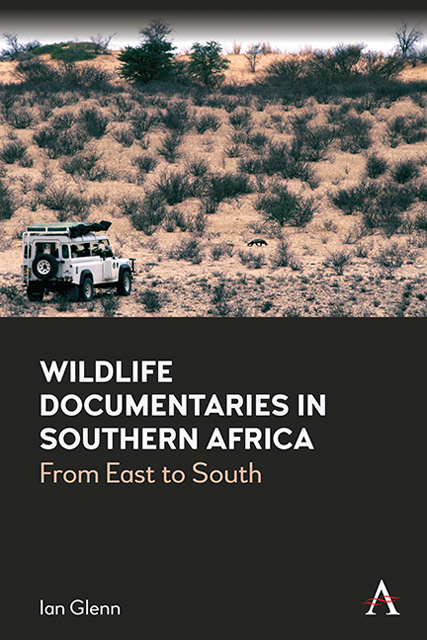Book contents
- Frontmatter
- Dedication
- Contents
- List of Figures
- Acknowledgements
- Introduction
- Chapter 1 What do the Critics Say?
- Chapter 2 A Theoretical Coalition?
- Chapter 3 Gone South: From East to Southern Africa
- Chapter 4 Private Lodges, Infrastructures and Guides
- Chapter 5 Going South: The Results
- Chapter 6 The Early History
- Chapter 7 The South Africans Enter the Game
- Chapter 8 Michael Rosenberg and Partridge Films
- Chapter 9 David and Carol Hughes
- Chapter 10 The Bartletts in the Namib, the Liversedges in Botswana
- Chapter 11 John Varty, Elmon Mhlongo and Londolozi
- Chapter 12 Richard Goss and Kim Wolhuter
- Chapter 13 Dereck and Beverly Joubert
- Chapter 14 Other Major Contributors
- Chapter 15 Going Live: Africam And Wildearth
- Chapter 16 Craig and Damon Foster
- Chapter 17 Must Love Animals?
- Chapter 18 The Social Turn
- Chapter 19 The Future of the Genre
- Chapter 20 The Influence of the Genre
- Conclusion
- Filmography
- Plates
- References
- Index
Chapter 2 - A Theoretical Coalition?
Published online by Cambridge University Press: 10 January 2023
- Frontmatter
- Dedication
- Contents
- List of Figures
- Acknowledgements
- Introduction
- Chapter 1 What do the Critics Say?
- Chapter 2 A Theoretical Coalition?
- Chapter 3 Gone South: From East to Southern Africa
- Chapter 4 Private Lodges, Infrastructures and Guides
- Chapter 5 Going South: The Results
- Chapter 6 The Early History
- Chapter 7 The South Africans Enter the Game
- Chapter 8 Michael Rosenberg and Partridge Films
- Chapter 9 David and Carol Hughes
- Chapter 10 The Bartletts in the Namib, the Liversedges in Botswana
- Chapter 11 John Varty, Elmon Mhlongo and Londolozi
- Chapter 12 Richard Goss and Kim Wolhuter
- Chapter 13 Dereck and Beverly Joubert
- Chapter 14 Other Major Contributors
- Chapter 15 Going Live: Africam And Wildearth
- Chapter 16 Craig and Damon Foster
- Chapter 17 Must Love Animals?
- Chapter 18 The Social Turn
- Chapter 19 The Future of the Genre
- Chapter 20 The Influence of the Genre
- Conclusion
- Filmography
- Plates
- References
- Index
Summary
Introduction
Any study like this faces the challenge of how to do justice to the individual energy and efforts of filmmakers like the Hugheses and Jouberts but also to indicate the other forces shaping the emergence and development of the genre in Southern Africa. No one study could do justice to thousands of films and television broadcasts that emerged during this period. At the same time, the description of the conditions favouring the development of a creative industry without a sense of the creative power of the product seems trivial.
But the analysis of books and Wikipedia entries about wildlife films and nature documentaries suggests that nobody really has much idea of what one should be saying about them. Should a scholarly study provide a chronology of films and filmmakers with some analysis of key developments (Bousé 2000; Mitman 1999), or a kind of check of the social acceptability and influence of the statements in the films (Chris 2006), or look at the inner workings of one production company like the NHU? (Davies 1998; Gouyon 2019; Louson 2018).
Let me put the problem a little differently. Imagine you are asked to say something intelligent about the opening scene of Kalahari – Wilderness without Water (1983) in which eyes emerge from the dark and then a mysterious and barely known animal, a brown hyena, comes into focus close to the camera and chews on some old bones, with commentary on how well adapted for survival in the Kalahari they are. Literary scholars produce annotated scholarly editions of important texts, and on Amazon Prime Video now, one can with a click of a computer mouse see all sorts of details about elements of the scene: the actors; the music playing; the original plot. What might an Amazon Prime Video or scholarly edition of an important wildlife film list? It seems to me that none of the scholarly studies has a coherent idea of what should be there or how that would help our understanding of the film and its strengths. It seems we need theory.
- Type
- Chapter
- Information
- Wildlife Documentaries in Southern AfricaFrom East to South, pp. 23 - 30Publisher: Anthem PressPrint publication year: 2022



